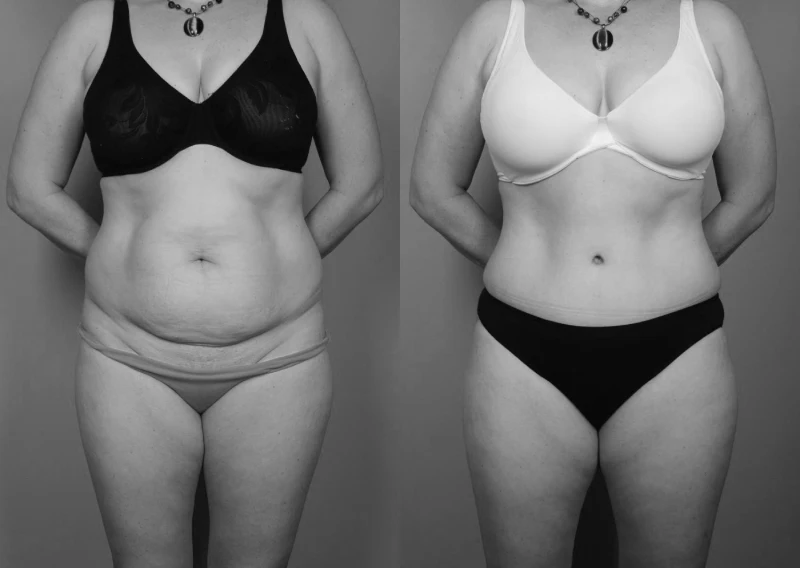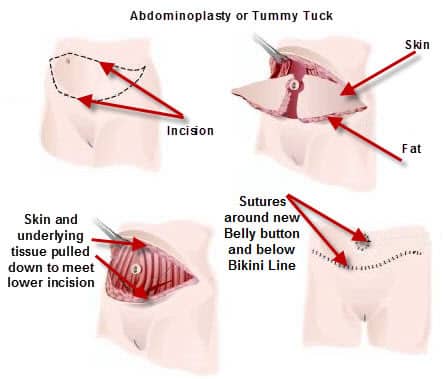Tummy Tuck in Mumbai
Tummy Tuck
As we navigate the inevitable changes brought on by aging, pregnancy, and substantial weight loss, the abdominal muscles can undergo a weakening process, often accompanied by the unwanted presence of sagging skin. Even in cases where there’s minimal fat, this combination can result in an aesthetically displeasing appearance. When liposuction proves insufficient, the answer lies in abdominoplasty, more commonly known as Tummy Tuck surgery. Going beyond a mere cosmetic fix, the Tummy Tuck emerges as a transformative remedy, seeking to restore strength and provide a firmer, more sculpted abdomen.
Abdominoplasty, commonly known as a tummy tuck, is a surgical procedure intended to eliminate excess skin and fat from the abdominal area while tightening the muscles of the abdominal wall. Often performed after significant weight loss or pregnancy, the goal is to enhance the overall appearance of the abdomen.

Who is the good candidate for the Tummy Tuck procedure?
- Have Excess Skin and Fat: Those with loose skin and stubborn fat deposits in the abdominal area, often due to factors like pregnancy, significant weight loss, or aging.
- Desire Abdominal Tightening: Individuals with weakened or separated abdominal muscles, seeking improved muscle tone and definition.
- Maintain Good Health: Generally healthy individuals without significant medical conditions that could pose risks during surgery or impede the healing process.
- Are at a Stable Weight: Candidates who have achieved a stable weight and are committed to maintaining it, as fluctuations can impact the long-term results.
- Non-Smokers: Non-smokers or those willing to quit, as smoking can increase the risk of complications and impair the healing process.
- Completed Childbearing: Women considering abdominoplasty should ideally have finished childbearing, as future pregnancies can affect the results.
Post-Pregnancy Transformation: Regaining Confidence After Childbirth
After the miraculous journey of pregnancy and childbirth, many women find themselves grappling with changes in their abdominal area. The stretching of muscles and skin during this transformative period can lead to a postpartum appearance that may not align with one’s desired self-image. Abdominoplasty, or Tummy Tuck surgery, becomes a valuable option for mothers seeking to reclaim their pre-pregnancy abdominal contours, helping restore both physical and emotional well-being.
Rediscovering Youthful Vitality in Your 40s: The Role of Abdominoplasty
Entering one’s 40s often brings a profound sense of self-reflection, and for some, a desire to counteract the natural effects of aging. Abdominoplasty serves as a powerful tool in this journey, addressing changes in muscle tone and skin elasticity that can occur with age. Beyond merely addressing physical aspects, this procedure aims to enhance overall attractiveness and rejuvenate one’s appearance, empowering individuals to embrace their evolving selves with confidence.
Navigating Weight Fluctuations: Abdominoplasty After Significant Weight Loss or Gain
Weight fluctuations, whether due to lifestyle changes or other factors, can result in excess skin and a lack of abdominal tone. Abdominoplasty steps in as a transformative solution, providing individuals with the means to address these physical changes comprehensively. By removing excess skin and tightening abdominal muscles, the surgery offers a pathway to achieve a more balanced and contoured physique, allowing individuals to celebrate their weight loss achievements or address the aftermath of weight gain.
In each of these life stages, abdominoplasty emerges as a tailored solution, offering individuals the opportunity to enhance their physical appearance, restore confidence, and embrace the various chapters of life with renewed vitality and self-assurance
What are the types of abdominoplasty?
Traditional or Full Abdominoplasty:
- Addresses the entire abdominal area.
- Involves a horizontal incision above the pubic area and around the navel.
- Suitable for individuals with significant excess skin and muscle laxity.
Mini Abdominoplasty:
- Targets the lower abdomen below the navel.
- Requires a smaller incision compared to the traditional procedure.
- Ideal for those with mild to moderate skin and muscle concerns.
Extended Abdominoplasty:
- Extends the incision around the hips to address the flank area.
- Suitable for individuals with excess skin on the sides and lower abdomen.
Reverse Abdominoplasty:
- Involves an incision in the upper abdomen below the breasts.
- Primarily focuses on lifting the upper abdominal skin.
- Typically performed in conjunction with other procedures.
Floating Abdominoplasty (FAB Technique):
- Utilizes a short horizontal incision, similar to a mini tummy tuck.
- Addresses excess skin and muscle tightening.
- Provides a less invasive option with a quicker recovery.
What is the procedure for Tummy Tuck?
During an abdominoplasty, a plastic surgeon begins by making an incision above the pubic area. The excess skin and fat in the lower abdomen are removed, and liposuction may be used for additional fat reduction. Abdominal muscles are tightened by suturing them together, contributing to improved tone. The repositioning of the belly button is sometimes performed for a more natural appearance. Once these steps are completed, the incisions are carefully closed with sutures, resulting in a more sculpted and rejuvenated abdominal profile.

What are the benefits of Tummy Tuck?
- Smoother Abdominal Appearance-Removes extra skin and fat for a more sculpted look.
- Tighter Muscles-Firms and tightens abdominal muscles.
- Increased Confidence-Boosts self-esteem with a flatter stomach.
- Stretch Mark Improvement-May improve the appearance of stretch marks.
- Better Clothing Fit-Allows for better-fitting clothes.
Post-Pregnancy Restoration-Restores pre-pregnancy abdominal appearance.
Functional Comfort-Addresses physical discomfort caused by excess skin.
